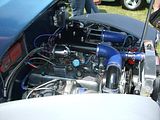I'm in the process of learning things regarding valve to piston clearance measurements when using hydraulic lifters.
As I understand one should measure the clearance by using a solid lifter and adjust for zero lash (when possible) or to using a solid lifter with your actual lifter pre-load correction.
Either way one should regard a clearance of approx .100" for the inlet valve. Some say an absolute minimum of .050" could be ok to.
This clearance is for: expanding components due to heat, valve bounce and pump up action when revving the engine to high.
I hope I'm correct up to now.
But the following thing is bothering me because I don't understand this. How does a lifter looks like in a pumped up state due to high revving on the end of the opening movement of the inlet valve (maximum lift)?
This in three situations:
1- Standard lifter
2- High revving lifter
3- Roads Bleed down lifter
In case of lifter C one should take into account a additional clearance of not 1.6 (rocker ration) times the pre-load but als times the pre-load with .030" for the small plunger in the middle.
I made a drawing to explain things.
Many thanks for your help
Frank










